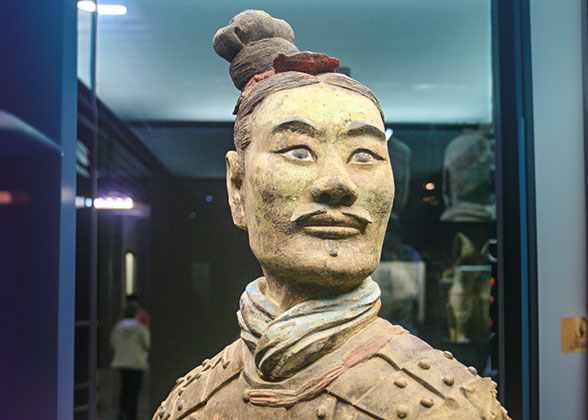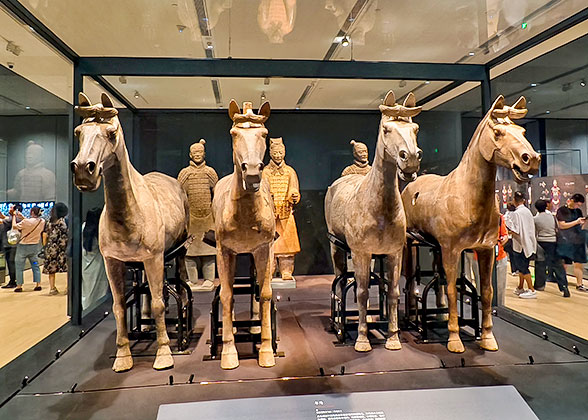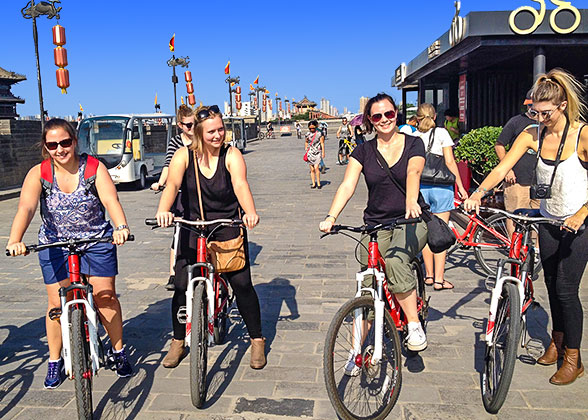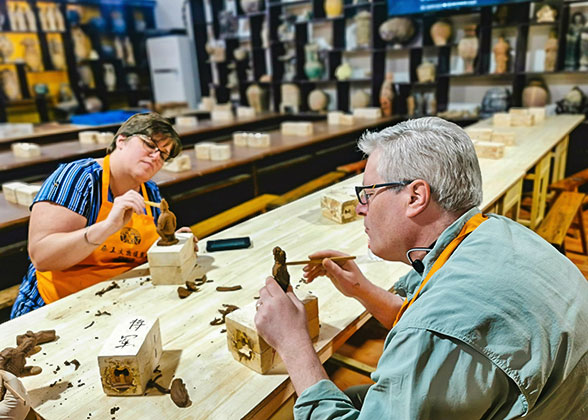The Bronze Chariots and Horses Museum is located within the
Emperor Qinshihuang's Mausoleum Site Museum, also known as Lishan Garden. It showcases two large-scale models of bronze chariots and horses, labeled "No.1 Bronze Chariot and Horses" and "No.2 Bronze Chariot and Horses" based on their excavation order. These half-size replicas of real chariots and horses from the
Qin Dynasty (221 - 207 BC) served as ceremonial vehicles for
Emperor Qin Shi Huang’s inspection tours in his afterlife, with carefully recreated details. Cast in bronze with painted surfaces, the chariots and horses are equipped with various weapons and decorated with gold and silver ornaments. They are the earliest, most complex, largest, and best-preserved bronze chariots and horses ever found in China, earning the title "Crown of Bronze" and hailed as the ultimate luxury vehicles of ancient China.
Additionally, the museum's second floor features replicas of parts and cargo from the chariots and horses displayed in multiple cases, allowing visitors to observe their intricate craftsmanship up close.
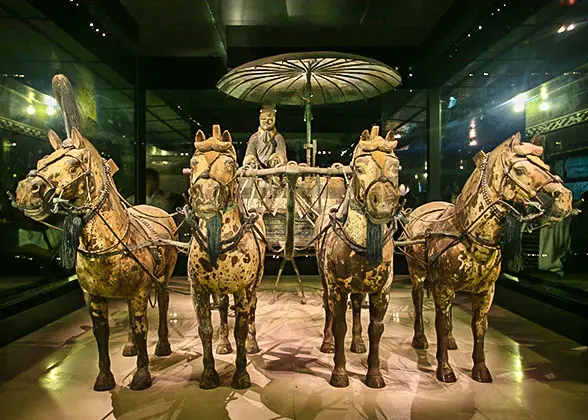 | | No.1 Bronze Chariot and Horses | | 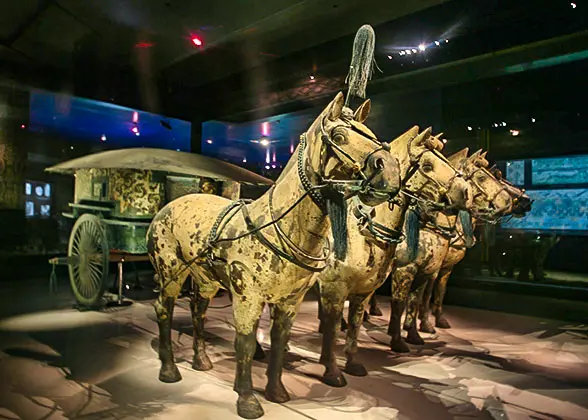 | | No.2 Bronze Chariot and Horses | |
In December 1980, these two bronze chariots and horses were excavated about 20 meters (22 yards) west of the Qin Shi Huang Mausoleum at a depth of 7.8 meters (25.6 feet). They were originally enclosed in wooden chambers that had been buried for over two thousand years. Although unearthed in over 3,000 fragments, the pieces mostly kept their original positions with all components intact. After eight years of careful restoration, the chariots were fully reconstructed and displayed to the public.
What to see?
No.1 Bronze Chariot and Horses
Measurement: 225 cm long x 152 cm high (89 x 60 in.)
Weight: 1,061 kilograms (2,339 pounds)
The No.1 bronze chariot, known as the "Standing Chariot", was designed for inspections, hunting, or sightseeing. Its compartment features an open structure resembling a modern tricycle carriage, with a standing charioteer positioned at the front inside the compartment, driving four proudly erect bronze horses. At the center of the compartment stands a bronze umbrella whose design is similar to that of modern umbrellas, and it is considered the earliest known sunshade in the world. The chariot is equipped with some weapons, including a bronze crossbow, shield, and arrowheads, along with gold and silver ornaments weighing over 3,000 grams (6.6 pounds).
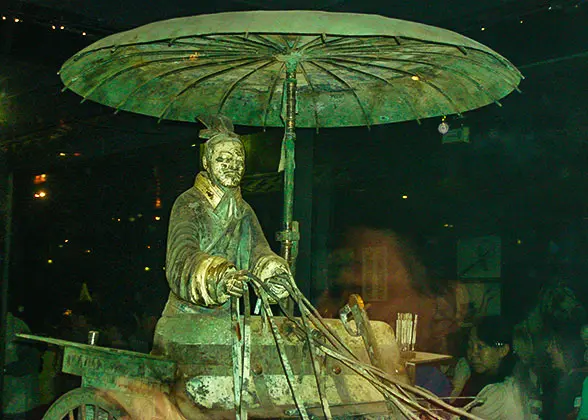 | | Charioteer Standing inside the Compartment | | 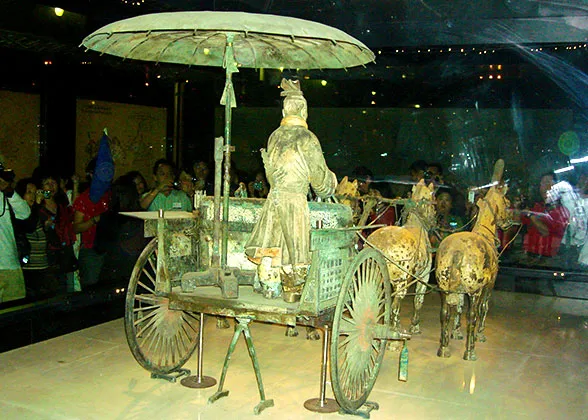 | | The compartment has an open structure. | |
No.2 Bronze Chariot and Horses The Bronze Horses Driving the Chariots
Measurement: 317 cm long x 106 cm high (125 x 42 in.)
Weight: 1,241 kilograms (2,736 pounds)
The No.2 bronze chariot, called the "Seated Chariot", was designed for long-distance travel and rest. Also pulled by four horses, it features a kneeling charioteer behind the horses. Its main character is the enclosed compartment, measuring 78 cm (30.7 in.) wide and 88 cm (34.6 in.) deep, divided into front and rear sections. The smaller front section serves as the charioteer’s seat, with a lift-side door for boarding, while the spacious rear section allows passengers to sit or lie down. The chariot has three windows: one on the partition wall between sections and two on each side of the compartment, with the main door at the back. The roof is covered by a near-circular canopy with a radius of about 65 cm (25.6 in.), embodying the design of "round heaven and square earth," which symbolizes the Chinese pursuit of a harmonious life. Decorative patterns adorn both the inside and outside of the compartment, complemented by gold and silver ornaments weighing approximately 4,000 grams (8.8 pounds).
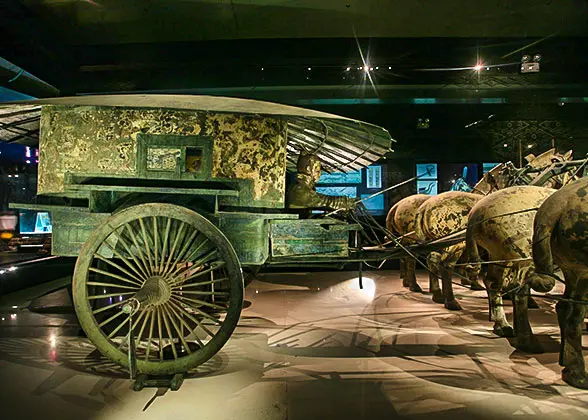 | | Side View of No.2 Bronze Chariot and Horses | | 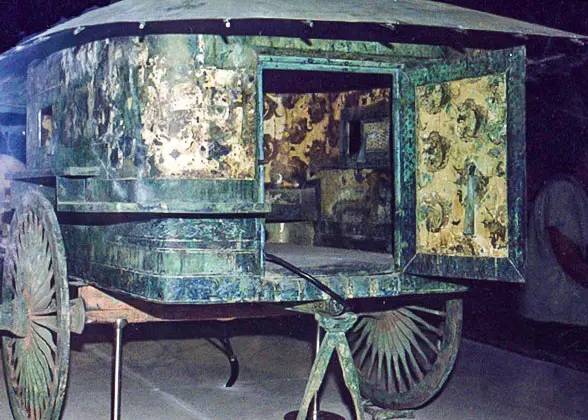 | | The door is on the back of the chariot. | |
The Bronze Horses Driving the Chariots
Each bronze chariot is pulled by four bronze horses. These horses are depicted with powerful muscles and lifelike expressions. Their bodies are white, with pink drawings painted on their muzzles. Their harnesses and ornaments are fully intact, with the gold and silver decorations making up half of the total components. The two horses in the middle bear the main pulling forces and are directly connected to the chariot shaft, while the outer horses assist in pulling and help maintain direction. To precisely control the horse's position and ensure synchronized pulling, Qin craftsmen designed ingenious control mechanisms that kept the four horses at proper distances, neither interfering with each other nor hindering their combined effort.
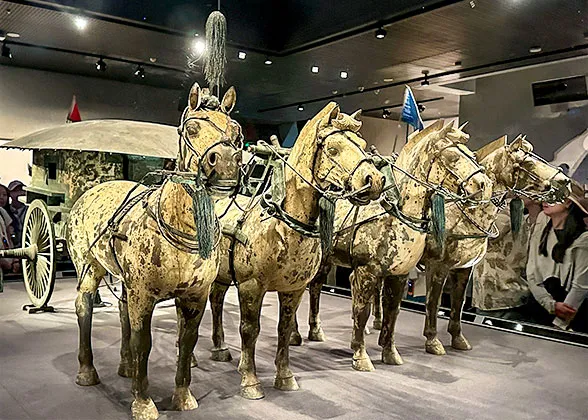 | | Four Powerful Bronze Horses | | 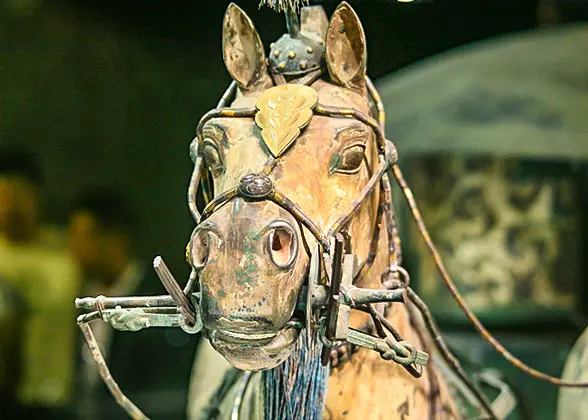 | | Bronze Horse with Gold Ornaments | |
Cultural Relics in the Display Case
On the second floor of the Bronze Chariots and Horses Museum, replicas of key components and decorations of the bronze chariots and horses are displayed by category. For instance, the horse's gold forhead ornament, the gold annular components of the bronze umbrella, and the connecting rings of the reins. Though theses exhibits, visitors can observe the details up close, gaining an appreciation for the advanced craftsmanship and luxious royal chariots and horses of ancient times.
Why the Bronze Chariots and Horses Are Hailed as "The Crown of Bronze"?
1. The Largest, Most Complex, and Best-preserved Bronze Chariots and Horses
2. Unparalleled Bronze Craftsmanship
Over 5,000 components are assembled using techniques like casting and welding, with seams as fine as a hair. The horse headgear consists of 160 gold and silver threads woven together, while the chains are connected by clasps, rivaling modern machinery. Most astonishingly, the large, thin curved canopies of both chariots were cast at one time, then shaped through high-temperature forging. The manufacturing of bronze chariots and horses exemplifies the extraordinary skill of Qin-dynasty bronze craftsmanship.
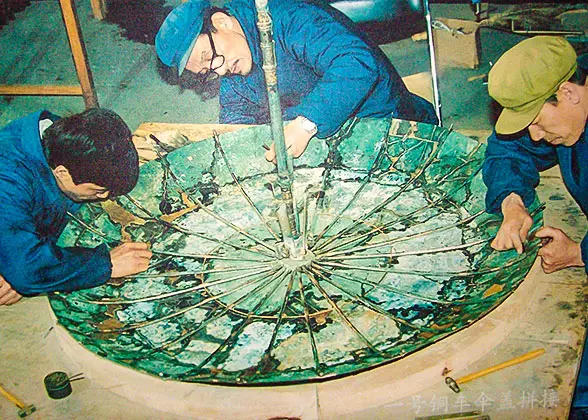 | | The Umbrella of the Chariot under Repair | | 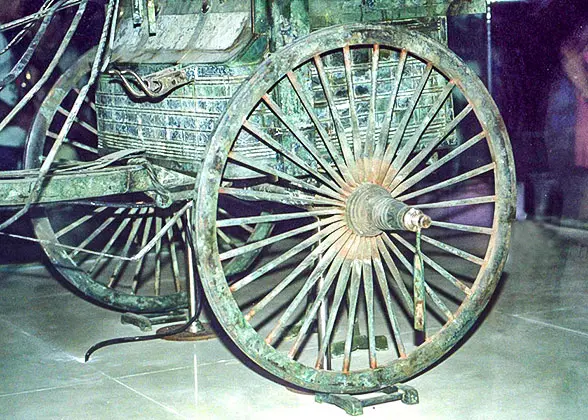 | | The Wheels of the Chariot | |
3. Millennium-Old Exquisite Colored Drawings
The bronze chariots and horses are not just one uniform bronze color but are decorated with detailed patterns painted using mineral pigments. The colorful designs mainly include white, blue, and green, with different patterns layered to give a three-dimensional look. The charioteer’s cheeks are painted pink, his robe blue, while the horses’ muzzles are painted pale pink, making them remarkably lifelike. These paintings are not only decorative but also represent the earliest known use of painted designs on bronze artifacts.
4. Vivid and Lifelike Expressions
The bronze horses and charioteers are crafted very vividly and realistically. The horses have well-defined muscles and sturdy legs, standing still yet full of energy. The charioteer’s facial features are detailed, with a handlebar mustache and a humble, complex expression; even his finger joints are carefully rendered. The craftsmen from the Qin dynasty captured the moment when the charioteer gently pulls the reins, showing subtle emotions and bringing vitality to the cold bronze.
Tips for Visiting the Bronze Chariots and Horses Museum
1. The Bronze Chariots and Horses Museum is located in Lishan Garden, separate from the three exhibition pits of the Terracotta Warriors and Horses Museum. It's about a 5-minute shuttle ride away, and visitors can take free shuttle buses to get to Lishan Garden.
2.
Lishan Garden stops ticket checking at 17:00, so plan your visit accordingly. You'd better depart from the Terracotta Warriors and Horses Museum before 16:30.

You may like:
- Last updated on Jan. 20, 2026 by Sherry Xia -
![]() Next: Qin Shi Huang Mausoleum
Next: Qin Shi Huang Mausoleum










